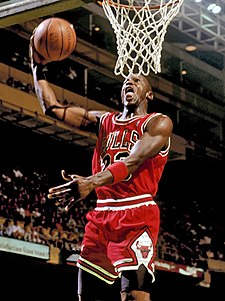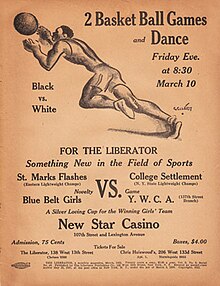Basketball

Basketball is a team sport in which two teams of five players try to score points by throwing or "shooting" a ball through the top of a basketball hoop while following a set of rules. Basketball is one of the most popular and widely viewed sports in the world.
A regulation basketball hoop consists of a rim 18 inches (45.7 cm) in diameter and 10 feet (3.05 m) high mounted to a backboard. A team can score a field goal by shooting the ball through the hoop during regular play. A field goal scores two points for the shooting team if a player is touching or closer to the hoop than the three-point line, and three points (a "3 pointer") if the player is "outside" the three-point line. The team with more points at the end of the game wins, but additional time (overtime) may be issued when the game ends with a tie. The ball can be advanced on the court by bouncing it while walking or running (dribbling) or passing it to a teammate. It is a violation (traveling) to walk with the ball, carry it, or to double dribble (to hold the ball and then resume dribbling).
Various violations are generally called "fouls". Disruptive physical contact (a personal foul) is penalized, and a free throw is usually awarded to an offensive player if he is fouled while shooting the ball. A technical foul may also be issued when certain infractions occur, most commonly for unsportsmanlike conduct on the part of a player or coach. A technical foul gives the opposing team a free throw.

Basketball has evolved many commonly used techniques of shooting, passing, and dribbling, as well as specialized player positions and offensive and defensive structures (player positioning) and techniques. Typically, the tallest members of a team will play "center", "small forward", or "power forward" positions, while shorter players or those who possess the best ball handling skills and speed play "point guard" or "shooting guard".
While competitive basketball is carefully regulated, numerous variations of basketball have developed for casual play. Competitive basketball is primarily an indoor sport played on carefully marked and maintained basketball courts, but less regulated variations are often played outdoors in both inner city and rural areas.
History of basketball
In early December 1891, Dr. James Naismith,a Canadian-born physical education professor and instructor at the International Young Men's Christian Association Training Schoo (YMCA) (today, Springfield College) in Springfield, Massachusetts, USA, was trying to keep his gym class active on a rainy day. He sought a vigorous indoor game to keep his students occupied and at proper levels of fitness during the long New England winters. After rejecting other ideas as either too rough or poorly suited to walled-in gymnasiums, he wrote the basic rules and nailed a peach basket onto a 10-foot (3.05 m) elevated track. In contrast with modern basketball nets, this peach basket retained its bottom, and balls had to be retrieved manually after each "basket" or point scored; this proved inefficient, however, so the bottom of the basket was removed, allowing the balls to be poked out with a long dowel each time. The peach baskets were used until 1906 when they were finally replaced by metal hoops with backboards. A further change was soon made, so the ball merely passed through, paving the way for the game we know today. An association football was used to shoot baskets. Whenever a person got the ball in the basket, his team would gain a point. Whichever team got the most points won the game. The baskets were originally nailed to the mezzanine balcony of the playing court, but this proved impractical when spectators on the balcony began to interfere with shots. The backboard was introduced to prevent this interference; it had the additional effect of allowing rebound shots.

Naismith's handwritten diaries, discovered by his granddaughter in early 2006, indicate that he was nervous about the new game he had invented, which incorporated rules from a children's game called "Duck on a Rock", as many had failed before it. Naismith called the new game "Basket Ball".
Early American professional and barnstorming teams
Teams abounded throughout the 1920s. There were hundreds of men's professional basketball teams in towns and cities all over the United States, and little organization of the professional game. Players jumped from team to team and teams played in armories and smoky dance halls. Leagues came and went. Barnstorming squads such as the Original Celtics and two all-African American teams, the New York Renaissance Five ("Rens") and (still in existence as of 2010) the Harlem Globetrotters played up to two hundred games a year on their national tours.

American national college championships
The first men's national championship tournament, the National Association of Intercollegiate Basketball tournament, which still exists as theNational Association of Intercollegiate Athletics (NAIA) tournament, was organized in 1937. The first national championship for NCAA teams, the National Invitation Tournament (NIT) in New York, was organized in 1938; the NCAA national tournament would begin one year later.
College basketball was rocked by gambling scandals from 1948 to 1951, when dozens of players from top teams were implicated in match fixing and point shaving. Partially spurred by an association with cheating, the NIT lost support to the NCAA tournament.
Equipment
The only essential equipment in a basketball game is the basketball and the court: a flat, rectangular surface with baskets at opposite ends. Competitive levels require the use of more equipment such as clocks, scoresheets, scoreboard(s), alternating possession arrows, and whistle-operated stop-clock systems.
A regulation basketball court in international games is 28 metres (91.9 ft) long and 15 metres (49.2 ft) wide. In the NBA and NCAA the court is 94 feet (28.7 m) by 50 feet (15.2 m). Most courts have wood flooring, usually constructed from maple planks running in the same direction as the longer court dimension.The name and logo of the home team is usually painted on or around the center circle.

The basket is a steel rim 18 inches (45.7 cm) in diameter with an attached net affixed to a backboard that measures 6 feet (182.9 cm) by 3.5 feet (106.7 cm), and one basket is at each end of the court. The white outlined box on the backboard is 18 inches (45.7 cm) high and 2 feet (61.0 cm) wide. At almost all levels of competition, the top of the rim is exactly 10 feet (305 cm) above the court and 4 feet (121.9 cm) inside the baseline. While variation is possible in the dimensions of the court and backboard, it is considered important for the basket to be of the correct height - a rim that is off by just a few inches can have an adverse effect on shooting.
The size of the basketball is also regulated. For men, the official ball is 29.5 inches (74.9 cm) in circumference (size 7, or a "295 ball") and weighs 22 ounces (624 g). If women are playing, the official basketball size is 28.5 inches (72.4 cm) in circumference (size 6, or a "285 ball") with a weight of 20 ounces (567 g).
Fouls
An attempt to unfairly disadvantage an opponent through physical contact is illegal and is called a foul. These are most commonly committed by defensive players; however, they can be committed by offensive players as well. Players who are fouled either receive the ball to pass inbounds again, or receive one or more free throws if they are fouled in the act of shooting, depending on whether the shot was successful. One point is awarded for making a free throw, which is attempted from a line 15 feet (4.6 m) from the basket.
The referee may use discretion in calling fouls (for example, by considering whether an unfair advantage was gained), sometimes making fouls controversial calls or no-calls. The calling of fouls can vary between games, leagues and even among referees.

A player or coach who shows poor sportsmanship, such as by arguing with a referee or by fighting with another player, can be charged with a more serious foul called a technical foul. The penalty involves free throws (where, unlike a personal foul, the other team can choose any player to shoot) and varies among leagues. Repeated incidents can result in disqualification. Blatant fouls with excessive contact or that are not an attempt to play the ball are called intentional fouls (or flagrant fouls in the NBA). In FIBA, a foul resulting in ejection is called a disqualifying foul, while in leagues other than the NBA, such a foul is referred to as flagrant.
If a team exceeds a certain limit of team fouls in a given period (quarter or half) – four for NBA and international games – the opposing team is awarded one or two free throws on all subsequent non-shooting fouls for that period, the number depending on the league. In the US college and high school games, if a team reaches 7 fouls in a half, the opposing team is awarded one free throw, along with a second shot if the first is made. This is called shooting "one-and-one". If a team exceeds 10 fouls in the half, the opposing team is awarded two free throws on all subsequent fouls for the half.
When a team shoots foul shots, the opponents may not interfere with the shooter, nor may they try to regain possession until the last or potentially last free throw is in the air.
After a team has committed a specified number of fouls, it is said to be "in the penalty". On scoreboards, this is usually signified with an indicator light reading "Bonus" or "Penalty" with an illuminated directional arrow indicating that team is to receive free throws when fouled by the opposing team. (Some scoreboards also indicate the number of fouls committed.)
If a team misses the first shot of a two-shot situation, the opposing team must wait for the completion of the second shot before attempting to reclaim possession of the ball and continuing play.
Positions
Although the rules do not specify any positions whatsoever, they have evolved as part of basketball. During the first five decades of basketball's evolution, one guard, two forwards, and two centers or two guards, two forwards, and one center were used. Since the 1980s, more specific positions have evolved, namely:
- point guard: usually the fastest player on the team, organizes the team's offense by controlling the ball and making sure that it gets to the right player at the right time
- shooting guard: creates a high volume of shots on offense; guards the opponent's best perimeter player on defense
- small forward: often primarily responsible for scoring points via cuts to the basket and dribble penetration; on defense seeks rebounds and steals, but sometimes plays more actively
- power forward: plays offensively often with their back to the basket; on defense, plays under the basket (in a zone defense) or against the opposing power forward (in man-to-man defense)
- center: uses height and size to score (on offense), to protect the basket closely (on defense), or to rebound.

The above descriptions are flexible. On some occasions, teams will choose to use a three guard offense, replacing one of the forwards or the center with a third guard. The most commonly interchanged positions are point guard and shooting guard, especially if both players have good leadership and ball handling skills.
























Post a Comment